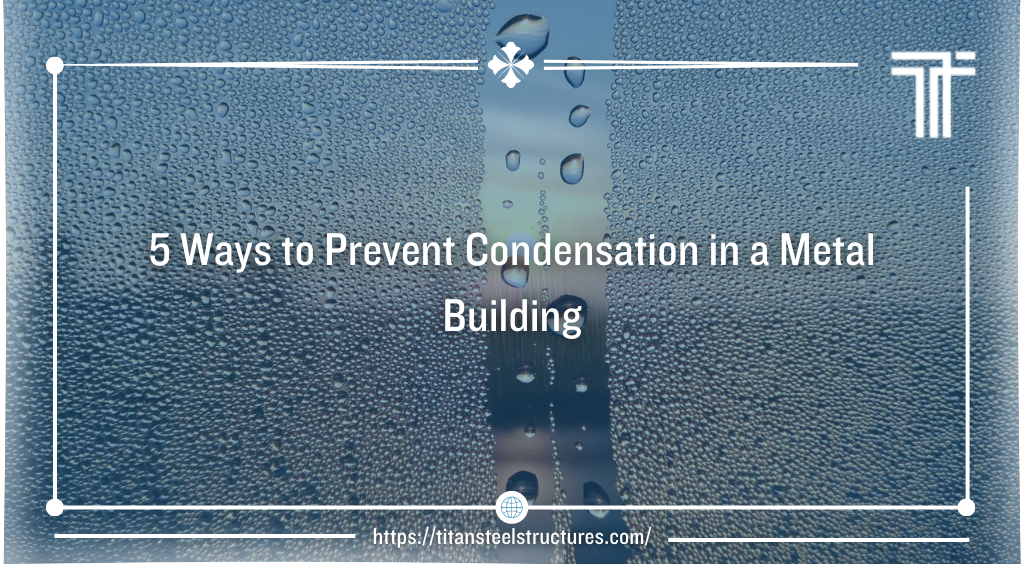Metal buildings are immune to many of the challenges that traditional materials present. Rot, mildew, and termite damage aren’t problems for steel structures, but excessive moisture can be. Humidity and condensation can lead to significant issues for your metal building and what’s inside it, but there are simple, affordable ways to prevent condensation in a metal building.
Whether you’re building a steel structure or you want to improve an existing one, reach out to the Titan Steel Structures experts today for information on the right metal building for you.
Why Should I Prevent Condensation in a Metal Building?
Metal buildings allow for a lot of flexibility and ingenuity. Irregular spaces can be used efficiently, and metal buildings hold up against pretty much whatever nature throws at them. A metal building is a great solution to a lot of problems.
So, why is excessive moisture such a big issue? High humidity can lead to condensation on the interior of your metal building. Figuring out how to prevent condensation can keep your building comfortable, dry, and safe for years to come.
First, let’s talk about why condensation happens. There are two things that create condensation: high humidity, and a big difference between the temperature inside and outside the building. To limit condensation, the building’s interior humidity levels should be between 30-50%. Humidity levels above 50% are more likely to cause condensation.
Warm air can generally contain more moisture than cooler air. If the interior temperature of a metal building is much warmer than the metal walls and roof, condensation can occur as warm air meets cold metal. This is more likely in environments with colder temperatures but can happen whenever there is a difference in temperature between the exterior and interior of the metal building.
There are two forms of condensation:
- Visible condensation – ice, frost, and water droplets you may see on skylights, cooling ducts, and cold water pipes
- Concealed condensation – the damaging condensation that forms on the interior of a building when the surface’s temperature is at or below the dew point
When condensation occurs in a metal building, it can lead to serious problems. Mold, mildew, and other allergens can grow quickly and make the building smell damp and musty. Wet insulation can corrode even surface-treated metal, which can degrade the integrity of your building over time.
If you’ve noticed condensation in your metal building or you want to avoid it from happening, keep reading to learn what steps to take.
Five Ways to Prevent Condensation in a Metal Building
There are two main objectives for preventing condensation in a metal building. First, you must keep the interior air from coming in contact with the colder metal roof and walls. Second, you must control the humidity inside the building.
Here are five ways to prevent condensation from causing damage to your metal building.
1. Continuous insulation
It’s not enough to put insulation between the metal studs and hope for the best. If you rely on minimal insulation, condensation can build up between the panels and soak into the insulation. For the best results, install continuous insulation. This extra step will keep warm, humid air from reaching your building’s interior. It will also keep the interior temperature of the building constant and avoid large fluctuations from day to night.
2. Adequate interior ventilation
Good ventilation can prevent excessive moisture from accumulating in the interior of the building and keep the humidity low. Dehumidifiers can be an effective solution, but they are often costly to install and maintain, and drainage can be a headache. A simpler solution? Run an air conditioner, keep windows open, and vent all heaters outside the building. Maintaining good airflow can lower the humidity inside the metal building and reduce condensation buildup.
3. Avoid sagging insulation
Sagging insulation is a common trap for moisture and condensation. Ensure your insulation is in complete contact with the underside of the roof. If there is a gap between the insulation and the ceiling, you’ve got a problem. Leaks and moisture from faulty flashing can build up and cause big problems down the road. Titan Steel Structures will make sure your insulation is installed correctly.
3. Watch for trouble below
Moisture can make its way into your metal building from the ground up, especially if the building is in a wet, soggy area. Adding a layer of drainage materials like gravel or crushed rock under your concrete slab may prevent condensation along the base of the building. It’s also important to drain roof runoff away from the foundation to keep the base as dry as possible during all weather.
4. Create a seal
Sealing your metal building well can help keep humidity low and prevent the significant differences in temperature that can lead to condensation. Seal windows, doors, side and end laps, and foundation sills well. Consider installing a vapor retarder that can limit interior humidity and moisture.
Many of these methods to prevent condensation in a metal building can be installed during construction or retrofitted afterward.
Reach Out Today
Want to learn more about preventing condensation in a metal building or constructing the structure you need? Contact the Titan Steel Structures pros today with your questions and ideas or fill out the form below.

